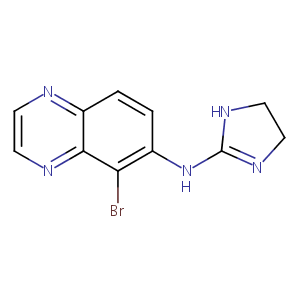Drug Information
| Drug General Information | Top | |||
|---|---|---|---|---|
| Drug ID |
D0AE3X
|
|||
| Former ID |
DIB014822
|
|||
| Drug Name |
Brimonidine
|
|||
| Synonyms |
brimonidine; 59803-98-4; Bromoxidine; UK 14,304; 5-Bromo-N-(4,5-dihydro-1H-imidazol-2-yl)-6-quinoxalinamine; 5-Bromo-6-(2-imidazolin-2-ylamino)quinoxaline; UK-14304; AGN 190342; UNII-E6GNX3HHTE; Brimonidine [INN:BAN]; UK 14304; C11H10BrN5; MLS000069370; 6-Quinoxalinamine, 5-bromo-N-(4,5-dihydro-1H-imidazol-2-yl)-; E6GNX3HHTE; CHEMBL844; AGN-190342; BRN 0751629; SMR000058355; CHEBI:3175; LK 14304-18; Brimonidine, 98%; NCGC00016069-09; EN300-50880; DSSTox_RID_80758; Brimonidine (bioerodible, extended release); [3H]brimonidine
Click to Show/Hide
|
|||
| Drug Type |
Small molecular drug
|
|||
| Indication | Ocular hypertension [ICD-11: 9C61.01; ICD-9: 365.04] | Approved | [1], [2] | |
| Glaucoma/ocular hypertension [ICD-11: 9C61; ICD-9: 365] | Phase 3 | [3] | ||
| Company |
PSivida Corp
|
|||
| Structure |
 |
Download2D MOL |
||
| Formula |
C11H10BrN5
|
|||
| Canonical SMILES |
C1CN=C(N1)NC2=C(C3=NC=CN=C3C=C2)Br
|
|||
| InChI |
1S/C11H10BrN5/c12-9-7(17-11-15-5-6-16-11)1-2-8-10(9)14-4-3-13-8/h1-4H,5-6H2,(H2,15,16,17)
|
|||
| InChIKey |
XYLJNLCSTIOKRM-UHFFFAOYSA-N
|
|||
| CAS Number |
CAS 59803-98-4
|
|||
| PubChem Compound ID | ||||
| PubChem Substance ID |
10088, 456619, 840957, 842087, 855898, 5580998, 7978815, 8151624, 11111939, 11113354, 14751364, 14922559, 17405770, 24277812, 26751556, 29215016, 29221599, 46507305, 47216864, 47515407, 48259343, 50043889, 50100366, 50104157, 50104158, 50500871, 51091862, 53778322, 53788848, 56422176, 56464105, 57321312, 62132787, 85209347, 85231282, 90340645, 92303234, 92717780, 93166807, 103144193, 103221477, 104170136, 104171261, 104300578, 117387171, 117389891, 118048633, 118874971, 121361838, 121362629
|
|||
| ChEBI ID |
CHEBI:3175
|
|||
| ADReCS Drug ID | BADD_D00294 | |||
| Target and Pathway | Top | |||
|---|---|---|---|---|
| Target(s) | Adrenergic receptor Alpha-2 (ADRA2) | Target Info | Agonist | [4] |
| Adrenergic receptor alpha-2C (ADRA2C) | Target Info | Modulator | [1] | |
| KEGG Pathway | cGMP-PKG signaling pathway | |||
| Neuroactive ligand-receptor interaction | ||||
| Panther Pathway | Alpha adrenergic receptor signaling pathway | |||
| Heterotrimeric G-protein signaling pathway-Gi alpha and Gs alpha mediated pathway | ||||
| Reactome | Adrenoceptors | |||
| Adrenaline signalling through Alpha-2 adrenergic receptor | ||||
| Adrenaline,noradrenaline inhibits insulin secretion | ||||
| G alpha (i) signalling events | ||||
| G alpha (z) signalling events | ||||
| Surfactant metabolism | ||||
| WikiPathways | Monoamine GPCRs | |||
| GPCRs, Class A Rhodopsin-like | ||||
| Platelet Aggregation (Plug Formation) | ||||
| Integration of energy metabolism | ||||
| GPCR ligand binding | ||||
| GPCR downstream signaling | ||||
| References | Top | |||
|---|---|---|---|---|
| REF 1 | URL: http://www.guidetopharmacology.org Nucleic Acids Res. 2015 Oct 12. pii: gkv1037. The IUPHAR/BPS Guide to PHARMACOLOGY in 2016: towards curated quantitative interactions between 1300 protein targets and 6000 ligands. (Ligand id: 520). | |||
| REF 2 | ClinicalTrials.gov (NCT00675207) Comparison of Brimonidine Purite, Dorzolamide, and Brinzolamide as Adjunctive Therapy to Prostaglandin Analogs. U.S. National Institutes of Health. | |||
| REF 3 | Drugs@FDA. U.S. Food and Drug Administration. U.S. Department of Health & Human Services. 2015 | |||
| REF 4 | Increased alpha2-adrenergic constriction of isolated arterioles in diffuse scleroderma. Arthritis Rheum. 2000 Aug;43(8):1886-90. | |||
If You Find Any Error in Data or Bug in Web Service, Please Kindly Report It to Dr. Zhou and Dr. Zhang.

